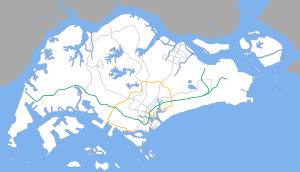Paya Lebar MRT station
EW8 CC9 Paya Lebar 巴耶利峇 பாய லேபார் Paya Lebar | ||||||||||||||||
|---|---|---|---|---|---|---|---|---|---|---|---|---|---|---|---|---|
| Rapid transit | ||||||||||||||||
.jpg) Paya Lebar MRT station (East West), with the Circle line in the far right corner. | ||||||||||||||||
| Location |
30 Paya Lebar Road 15 Paya Lebar Road Singapore 409006 / 409049 | |||||||||||||||
| Coordinates | 1°19′04″N 103°53′33″E / 1.317767°N 103.892381°E | |||||||||||||||
| Operated by | SMRT Trains (SMRT Corporation) | |||||||||||||||
| Line(s) | ||||||||||||||||
| Platforms |
Island (East West Line) Double Island (Circle line) | |||||||||||||||
| Tracks |
2 (East West Line) 3 (Circle Line) | |||||||||||||||
| Connections | Bus, Taxi | |||||||||||||||
| Construction | ||||||||||||||||
| Structure type |
Elevated (East West Line) Underground (Circle Line) | |||||||||||||||
| Platform levels | 2 | |||||||||||||||
| Parking | Yes (Paya Lebar Square, One KM) | |||||||||||||||
| Bicycle facilities | Yes | |||||||||||||||
| Disabled access | Yes | |||||||||||||||
| Other information | ||||||||||||||||
| Station code | EW8 CC9 | |||||||||||||||
| Fare zone | 2 | |||||||||||||||
| History | ||||||||||||||||
| Opened |
4 November 1989 (East West Line) 17 April 2010 (Circle Line) | |||||||||||||||
| Electrified | Yes | |||||||||||||||
| Services | ||||||||||||||||
| ||||||||||||||||
| Location | ||||||||||||||||
 | ||||||||||||||||
Paya Lebar MRT station (EW8/CC9) is a Mass Rapid Transit (MRT) interchange station on the East West Line and Circle Line in Geylang, Singapore. This station is located at the heart of the upcoming Paya Lebar Central, a commercial hub within Geylang.
It is the first MRT station in Singapore that serves as an interchange of both an elevated line (East West Line) and an underground line (Circle Line).
Despite its name, Paya Lebar station is not physically located in Paya Lebar planning area. The name was derived from the nearby Paya Lebar Road instead.
History
The station originally opened on 4 November 1989, serving the East West Line.[1]
On 16 March 2003, the section of Paya Lebar Road from Geylang East Central to Sims Avenue was closed to facilitate the construction of Circle MRT Line. Motorists diverted via the temporary road of Eunos Road 8. The affected section was reinstated on 23 August 2009, after the connection from the East West Line to the Circle Line was completed.
On 4 April 2007, a man died after being hit by a train along the East West Line sector at about 10.20 am. Police said the victim, a 52-year old Chinese, was pronounced dead by paramedics at 10.45 am. East-bound services were disrupted from Aljunied to Eunos for 41 minutes but resumed by 11.02 am.
On 17 April 2010, the Circle Line platforms opened,[2] shortening the travelling time from the station to Bishan where commuters can transfer to the North South Line, to 13 minutes.
As with most of the above-ground stations along the East West Line, the station was built without platform screen doors. Installation of half-height platform screen doors which prevent commuters from falling onto the train tracks started on 28 October 2010 and commenced operations on 11 January 2011 with Bedok.[3] The Circle Line side of this station has been equipped with full-height platform screen doors since the operations started on 17 April 2010. It is the first underground MRT station to have a middle platform, and is only usable until 14 January 2012, where short-trip service between HarbourFront & Paya Lebar were extended to Marina Bay. The middle platform is only usable when trains are withdrawn after evening peak.
The station was installed with high-volume low-speed fans, which have been in operation since 14 July 2012 together with Kembangan.[4]
Privacy screens were installed at some parts from Paya Lebar Road all the way to Geylang East Central, to minimise the noise impact from residents since October 2016 and completed in May 2017.[5]
Gallery
 Concourse level of Circle Line
Concourse level of Circle Line- The transfer linkway from East West Line to Circle Line
- Platform level of Circle Line
- The Circle Line segment of the MRT station under construction.
 Platform level of East West Line
Platform level of East West Line
References
- ↑ "Add soul to the steel". The Straits Times. 4 November 1989. Retrieved 20 October 2017 – via NewspaperSG.
- ↑ "Transport minister announces next phase of Circle Line will open on 17 Apr". Channel NewsAsia. 26 January 2010.
- ↑ Wong, Siew Ying (26 January 2008). "Above-ground MRT stations to have platform screen doors by 2012". Channel NewsAsia. Archived from the original on 30 July 2012. Retrieved 1 February 2012.
- ↑ "Enhancing Connectivity and Comfort for Commuters". Land Transport Authority. 13 October 2011. Archived from the original on 25 December 2012. Retrieved 6 July 2012.
- ↑ Railway Noise Barriers on Track
External links
| Wikimedia Commons has media related to Paya Lebar MRT Station. |